

Life in Anglo-Saxon England. 1.

Introduction The Anglo-Saxon period lasted for some six centuries, from the arrival of Germanic invaders from the continent during the early fifth century AD to the Norman Conquest of 1066. This was a time of immense political and social upheaval which saw major changes in almost all aspects of everyday life. The early pagan settlers lived mainly by farming (see Unit 9, Farming), and formed a number of separate — and warring — kingdoms. By around 700 AD, there appears to have been a ‘Heptarchy’ of seven kingdoms (Northumbria, Mercia, East Anglia, Wessex, Essex, Sussex and Kent), while the main four in the ninth century were Northumbria, Mercia, East Anglia and Wessex. 2.
Anglo-Saxon kings were prolific legislators, and a number of law-codes survive from the seventh to eleventh centuries. 3. 4. A substantial literature survives from Anglo-Saxon England in both Latin and Old English. Other original writings in Old English include sermons, saints’ lives and wills. 5. 6. 7. Websites. Anglo-Saxon England - culture and society. The strongest ties in Anglo-Saxon society were to kin and lord.
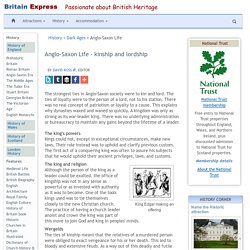
The ties of loyalty were to the person of a lord, not to his station. There was no real concept of patriotism or loyalty to a cause. This explains why dynasties waxed and waned so quickly. A kingdom was only as strong as its war-leader king. There was no underlying administration or bureaucracy to maintain any gains beyond the lifetime of a leader.
The king's powersKings could not, except in exceptional circumstances, make new laws. King Edgar making an offering. The Style of Anglo-Saxon Poetry on JSTOR. Intro to Anglo Saxon culture and literary elements. Anglo-saxon. Early History of England The island was originally inhabited by Celtic tribes from Central Asia prior to the invasion by the Romans c. 50-100CE.
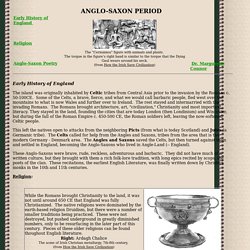
Some of the Celts, a brave, fierce, and what we would call barbaric people, fled west over the mountains to what is now Wales and further over to Ireland. Anglo-Saxon literature: Poetry. There are two types of Old English poetry: the heroic, the sources of which are pre-Christian Germanic myth, history, and custom; and the Christian.
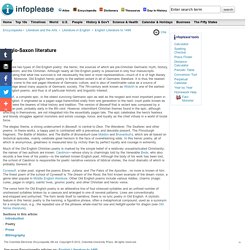
Although nearly all Old English poetry is preserved in only four manuscripts—indicating that what has survived is not necessarily the best or most representative—much of it is of high literary quality. Moreover, Old English heroic poetry is the earliest extant in all of Germanic literature. It is thus the nearest we can come to the oral pagan literature of Germanic culture, and is also of inestimable value as a source of knowledge about many aspects of Germanic society. The 7th-century work known as Widsith is one of the earliest Old English poems, and thus is of particular historic and linguistic interest. Beowulf, a complete epic, is the oldest surviving Germanic epic as well as the longest and most important poem in Old English.
The Columbia Electronic Encyclopedia, 6th ed. See more Encyclopedia articles on: English Literature to 1499. Old English Religious Poetry - Medieval Studies. Lack of precise information concerning the date and place of composition of almost all Old English poems remains a problem for literary histories of the period that runs roughly from Augustine of Canterbury’s mission in 597 to the Norman Conquest in 1066; see Fulk and Cain 2003 (especially pp. 36–37), which does not develop Fulk’s earlier chronology based on meter.
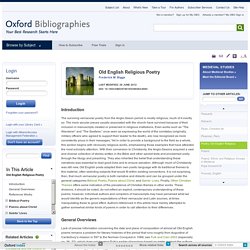
Instead the authors have, after a discussion of the Alfredian period, structured their overview around different kinds of writings, such as “Homilies” and “Saints’ Legends,” combining prose and poetry when relevant as well as works in Latin. Earlier, Greenfield and Calder 1986 began with a chapter on the Anglo-Latin background (written by Michael Lapidge) and then separated the prose from the poetry. Bjork, Robert E., ed. Cynewulf: Basic Readings. New York: Garland, 1996. Mod 6 Lesson 6.2.1 History of English: Old English. Pre-English Germanic Period Let's begin by first looking at the Germanic period, the pre-English period before the Germanic tribes migrated to the British Isles.

The Germanic tribes were but one offshoot of the Indo-Europeans, thought to have originated somewhere in Eastern Europe or in present day Turkey. Perhaps as early as 4000 BC, the various tribes who were to become the Germanic peoples began slowly to spread out over northern Europe. The Germanic peoples were not the first to colonize this area. To the northeast were the Finns, Estonians and related non-IE tribes who still live in northeastern Europe today. A) Words for the natural environment: when Germans migrated from the interior of Eastern Europe to the Baltic Sea, and encountered there new topographic and natural elements, they often borrowed aboriginal words to describe them: sea (cf.
Grimm's Law In short: all the IE voiceless stops had become voiceless fricatives. The History of English - Old English (c. 500 - c.1100) About 400 Anglo-Saxon texts survive from this era, including many beautiful poems, telling tales of wild battles and heroic journeys.
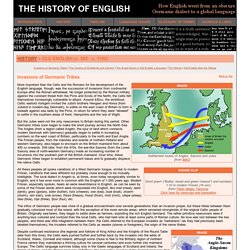
The oldest surviving text of Old English literature is “Cædmon's Hymn”, which was composed between 658 and 680, and the longest was the ongoing “Anglo-Saxon Chronicle”. But by far the best known is the long epic poem “Beowulf”. “Beowulf” may have been written any time between the 8th and the early 11th Century by an unknown author or authors, or, most likely, it was written in the 8th Century and then revised in the 10th or 11th Century. It was probably originally written in Northumbria, although the single manuscript that has come down to us (which dates from around 1000) contains a bewildering mix of Northumbrian, West Saxon and Anglian dialects.
The 3,182 lines of the work shows that Old English was already a fully developed poetic language by this time, with a particular emphasis on alliteration and percussive effects. History - Ancient History in depth: King Arthur, 'Once and Future King' History - Ancient History in depth: King Arthur, 'Once and Future King' The Anglo-Saxon kings. In the Dark Ages during the fifth and sixth centuries, communities of peoples in Britain inhabited homelands with ill-defined borders.
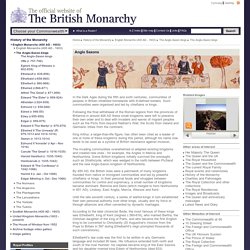
Such communities were organised and led by chieftains or kings. Following the final withdrawal of the Roman legions from the provinces of Britannia in around 408 AD these small kingdoms were left to preserve their own order and to deal with invaders and waves of migrant peoples such as the Picts from beyond Hadrian's Wall, the Scots from Ireland and Germanic tribes from the continent.
King Arthur, a larger-than-life figure, has often been cited as a leader of one or more of these kingdoms during this period, although his name now tends to be used as a symbol of British resistance against invasion. Ashmolean Museum: Anglo-Saxon Discovery - Arrival. Anglo-Saxon Culture. Anglo-Saxon.
Anglo-Saxons: a brief history. Publication date: 13th January 2011 King Arthur as one of the Nine Worthies, detail from the 'Christian Heroes Tapestry' This period is traditionally known as the Dark Ages, mainly because written sources for the early years of Saxon invasion are scarce.
